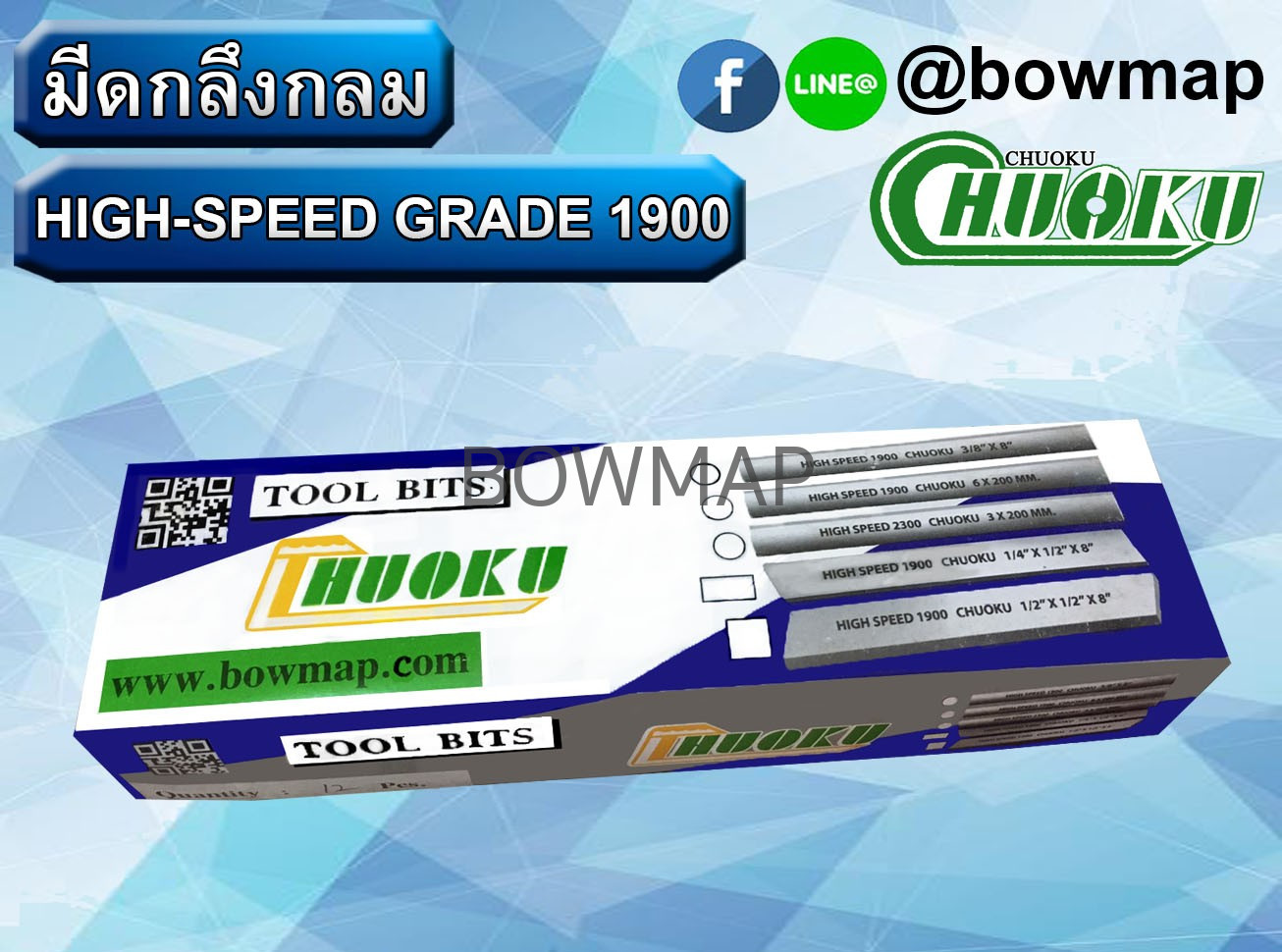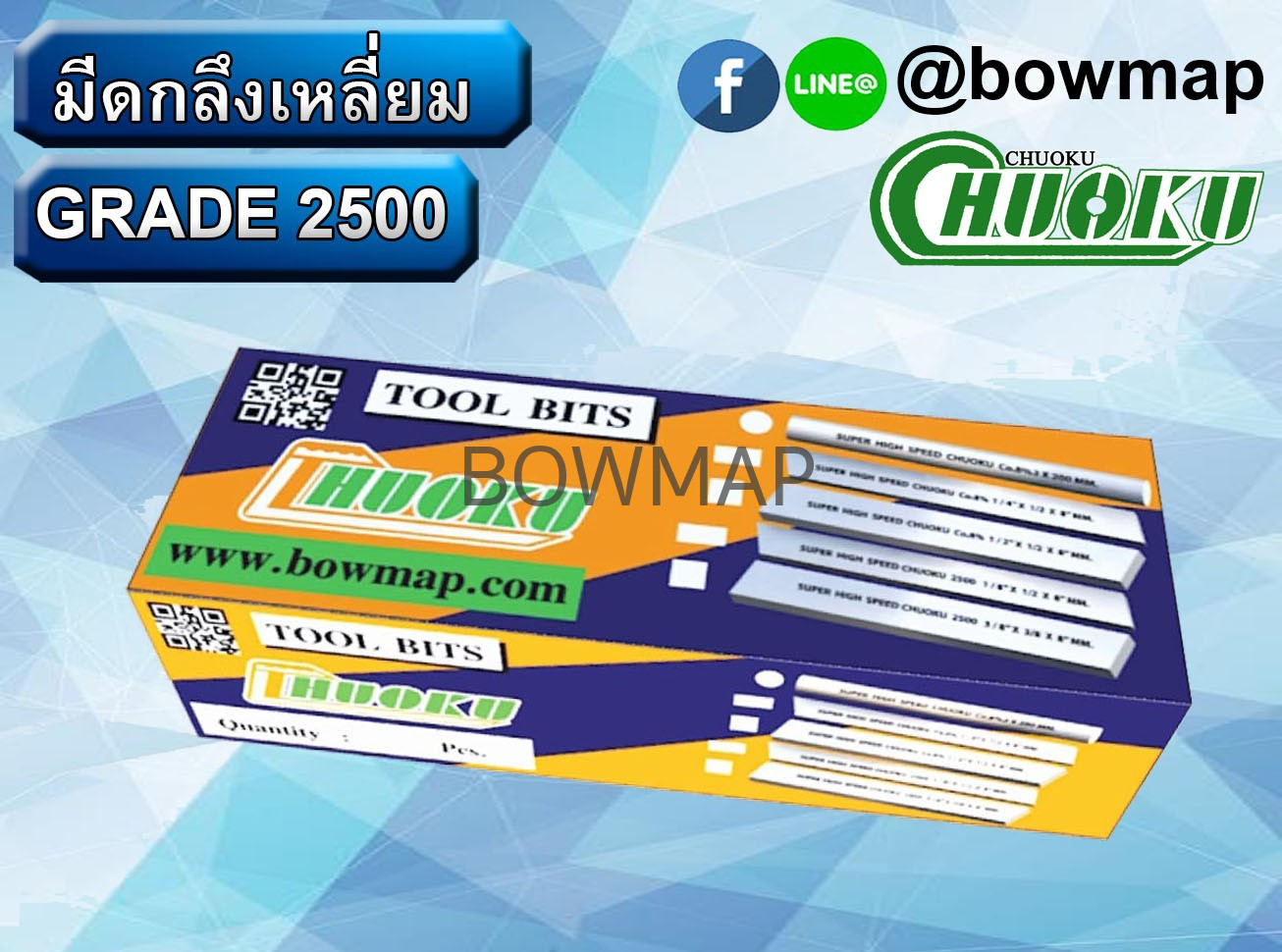- Category : 1.Turning / drilling / tapping / milling -Tool bits
- Brand : CHUOKU
- Product Code : -
Tool bits Grade 1900,2500,Co.8
is a device used to cut the work into the desired shape Because the properties of Tool bits are tough, they are resistant to cracking and have high heat resistance. Its main ingredient is iron.
There are 3 types of commonly used turning knives.
1. CHUOKU round Tool bits



2. CHUOKU Square Tool bits



3. CHUOKU Flat Tool bits



The angle of the lathe knife consists of 3 angles as follows:
1. Rake Angles - which will have both rear and front rake angles
*Comparison of cutting different materials with the rake angle of the Tool bits.
| Metals to cut | Brass/ cast iron |
solid steel/solid cast iron | Medium Carbon Ductile Iron/Soft Cast Iron | Mild steel/ low carbon steel | light metal aluminum |
| Puffing angle | 0° | 8° | 14° | 20°- 27° | 40° |
2. Clearance Angles - which have both front and side escape angles.
*Comparison of cutting clearance angle and rake angle of HSS turning knives.
| Machined material | front corner | side corner | top spit corner | side spit | cutting edge angle | side cutting edge |
| Turning mild steel | 8 | 10 | 12 | 15 | 70 | 65 |
| Turning tools | 8 | 10 | 8 | 12 | 74 | 68 |
| Turning cast iron | 8 | 8 | 5 | 12 | 77 | 70 |
| Brass lathe | 8 | 10 | 0 | 0 | 82 | 80 |
| Turning bronze | 8 | 10 | 0 | 0 | 82 | 80 |
| Machined aluminum | 8 | 12 | 35 | 15 | 47 | 63 |
3.Cutting Angles - which have both front and side cutting angles.
The method for selecting the cutting speed with the turning tool is as follows:
1.Materials used in turning -In case of hard metal material, cutting speed is lower than soft metal material.
2. Lathe or mechanical - In the case of an old lathe The lathe knife does not hold tightly.The cutting speed cannot be used in turning operations with a lathe in good condition.
3.Material from which the Tool bits is made.
Material Turning speed
Turning knife made of tungsten carbide and ceramic. -Use a high turning speed
Lathe knife made of high-speed steel. -Use a medium turning speed
Lathe knife made of high-carbon steel. -Use a low turning speed
4. Cutting depth and feed rate
Small depth of cut and feed - Able to use high cutting speed
Large depth of cut and feed - Can't use high cutting speed
Example *Average speed for turning with a HSS knife, in m/min.
| Material | coarse | fine | threaded |
| Aluminum | 61 | 93 | 18 |
| Bronze | 27 | 30 | 8 |
| cast iron | 18 | 24 | 8 |
| Tool steel | 21 | 27 | 9 |
| Mild steel | 27 | 30 | 11 |
Angle of Tool bits
sharpening a Tool bits Must be sharpened from various angles. according to the needs of the job, such as side clearance It must always be present so that the cutting process can be carried out easily. front corner It is there so that the cutting edge angle can cut effectively while moving forward.


1. A side-cutting angle-cutting knife (symbol X reads as kai) is a sharpening angle that is beveled at an angle to the edge of the insert.
2. The front angle turning knife (symbol Xn reads as Kaien) is a sharpening angle to avoid friction with the front cutting edge.
3. The front relief turning knife (symbol α, pronounced alpha) is the angle formed by the sharpening of the side relief and the front cutting angle.
4. The side-cutting knife (symbol αn reads as alpha N) is a sharpening angle that does not have a side-cutting knife in contact with the work surface.
5.The cutting edge combined angle turning knife (symbol ε, read epsilon) is the cutting edge angle formed by the side cutting angle and the front cutting angle.
6. Lathe knife rake angle (symbol y read that gamma) is a sharp angle that slopes down to the edge of the turning knife on the other side.
7. The wedge angle lathe knife (symbol β reads beta) is the angle formed by the side escaping and the rake angle.
Setting the turning knife at the level of zero or away from the center
Usually, the setting of the turning knife is set to exactly zero. If the cutting edge of the turning tool is set to escape from the center, most of the times it is preferable to turn the work surface, which does not affect the shape of the machined workpiece. But it affects the turning time of the work that may turn slowly due to the change in the angle of the knife. For other turning operations such as tapering, face milling, thread turning, etc., the cutter edge must be set to zero. because the lathe will not be as desired.
Turning precision
In order for the size of the lathe to be accurate, there must be good turning conditions, i.e. both the lathe, the lathe and the lathe must be in the right conditions, such as the machine power is sufficient and the lathe is stable. In addition, the use of the correct turning knife, both the material of the turning knife and the angle of the knife. Typically, the machining accuracy is as follows.
1.For turning/rough boring
-Sizes less than or more than 15 mm, can be machined/bored to a range of +- 0.15 mm.
-Sizes over 50 mm. can be machined/bored to be in the range of +- 0.40 mm.
2.For turning/fine boring
-Sizes less than or more than 15 mm, can be machined/bored in the range of +-0.05 mm.
-Sizes over 50 mm. can be machined/bored to a range of +-0.18 mm.
Tell 02-744-3871-5 ext. 102-105 FAX 02-748-5058
ID LINE : @BOWMAP Website : http://www.bowmap.com/th





